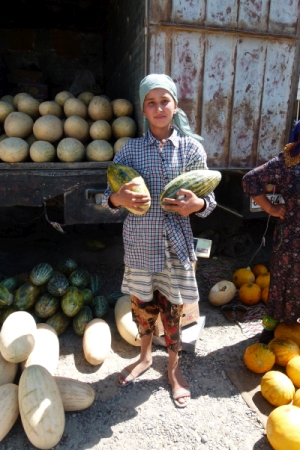

 In the global plant genetic database GENESYS, 8066 melon (Cucumis melo L.) accessions are present, which are maintained in 388 holding institutes of which 20 institutes hold more than 50 accessions. 4696 accessions are reported as landraces/traditional varieties and 214 accessions as wild/natural. The Centre for Genetic Resources, the Netherlands (CGN) holds 76 melon accessions.
In the global plant genetic database GENESYS, 8066 melon (Cucumis melo L.) accessions are present, which are maintained in 388 holding institutes of which 20 institutes hold more than 50 accessions. 4696 accessions are reported as landraces/traditional varieties and 214 accessions as wild/natural. The Centre for Genetic Resources, the Netherlands (CGN) holds 76 melon accessions.
It has been recently shown that melon has most probably a Central Asian origin and not, as has been thought a long time, an African origin (Sebastian et al. 2010). Therefore one could expect that in Central Asia, as a centre of melon biodiversity, a substantial amount of variation is present. As can be noted from Table 1 1766 melon accessions of Central Asian origin are reported in GENESYS of which 63% (1112/1766) are available for distribution. Most accessions collected originated from India, Afghanistan and Iran.
Table 1. The number of melon accessions originating from Central Asian countries present in genebanks worldwide according to GENESYS.
| Country | Not available | Available | Unknown | Total |
| Afghanistan | 170 | 205 | 11 | 386 |
| China | 9 | 33 | 41 | 83 |
| India | 120 | 647 | 35 | 802 |
| Iran | 87 | 123 | 5 | 215 |
| Kazakhstan | 1 | 5 | 6 | 12 |
| Kyrgyzstan | - | - | 3 | 3 |
| Pakistan | 23 | 17 | 27 | 67 |
| Tajikistan | 2 | 1 | 8 | 11 |
| Turkmenistan | 20 | 57 | 13 | 90 |
| Uzbekistan | 26 | 24 | 47 | 97 |
| Total | 458 | 1112 | 196 | 1766 |
Uzbekistan is since ancient times famous for its melons (Jermokhin et al. 1962, Mavlyanova et al. 2005, Hansen 2015), however its genetic resources are poorly represented in genebanks worldwide (Table 1). Therefore a collecting mission to this country is clearly warranted.
The collecting mission resulted in the collecting of 50 melon accessions amongst which 30 Amiri, 15 Chandalaks and 5 Zard accessions.